Dostoïevski a dit un jour : « Beaucoup de malheur est venu dans le monde à cause de l'égarement et des non-dits ».
Cependant, un manque de communication peut entraîner bien plus qu'un simple malheur.
Bien que Dostoïevski n'ait (probablement) pas pensé à la communication d'équipe lorsqu'il a écrit sa célèbre citation, le manque de communication ou une mauvaise communication peut conduire à un effondrement complet de l'équipe.
La communication au sein d'une équipe est importante, car lorsque les membres de l'équipe ne communiquent pas bien tout au long de leur travail commun, ils ne peuvent pas collaborer avec succès.
Dans ce guide, nous entrerons dans les détails de la communication d'équipe et de son importance, et nous aborderons des sujets tels que :
- La définition de base de la communication d'équipe,
- Les avantages d'une bonne communication d'équipe,
- Comment une mauvaise communication affecte une équipe.
Nous partagerons également des avis d'experts et des conseils sur la manière de communiquer efficacement au sein d'une équipe.
C'est parti !

Qu'est-ce que la communication d'équipe ?
Selon le site web des ressources humaines du MIT, une équipe est un groupe « formé délibérément et soigneusement pour répondre à des besoins de travail qu'un individu ou un groupe d'individus ne peut pas satisfaire aussi efficacement ».
Au fait, le même site définit le travail d'équipe comme « un engagement commun à l'égard du processus de l'équipe (la manière dont l'équipe travaille ensemble) et de son produit (le travail accompli par l'équipe) ».
Pour qu'il y ait travail d'équipe, les membres d'une équipe doivent travailler de manière interdépendante, mais aussi se réunir régulièrement pour :
- Prendre des décisions,
- Mener des discussions,
- Planifier le travail futur et
- Résoudre des problèmes.
Pour ce faire, l'équipe doit communiquer de manière fréquente et efficace.
La comunication en équipe : La définition
La communication d'équipe représente toutes les interactions et tous les échanges d'informations qui ont lieu au sein d'une équipe. Cela inclut divers :
- Types de communication (par exemple, interactions verbales, non verbales, écrites ou visuelles),
- Situations de communication (par exemple, les conversations individuelles, les entretiens d'embauche ou les réunions),
- Styles de communication (par exemple, les formes de communication agressives, passives ou assertives),
- Canaux de communication (appels téléphoniques, messages directs dans les applications de communication d'équipe ou emails), et
- Modèles de communication (par exemple, la communication unidirectionnelle, bidirectionnelle et bidirectionnelle complexe).
À la base, la communication d'équipe est une transmission d'informations.
Toutefois, pour que la communication d’équipe soit réellement efficace il faut que la transmission des informations soit réussie, c'est-à-dire que la personne qui partage les informations les transmette correctement et que la personne ou le groupe qui reçoit les informations les interprète correctement.
Les composantes de la communication
Afin d'améliorer la communication au sein d'une équipe, il est nécessaire de bien comprendre le processus de communication.
Selon divers modèles théoriques, le processus de communication est une série d'actions entreprises en vue de communiquer un message avec succès. Il comprend 8 composantes principales :
- L'émetteur (initiateur de la communication),
- Le message (une information, une pensée ou une idée transmise à d'autres),
- Le codage (processus de transformation d'une pensée ou d'une idée en communication),
- Le bruit (tout ce qui interfère et déforme le message voulu),
- Le canal (comment un message voyage entre l'émetteur et le récepteur),
- Le récepteur (la personne qui reçoit et interprète le message),
- Le décodage (le processus de compréhension des pensées et des idées communiquées), et
- Le feedback (la réponse du récepteur au message).
En outre, le message est façonné par l'environnement et le contexte dans lequel il se produit.
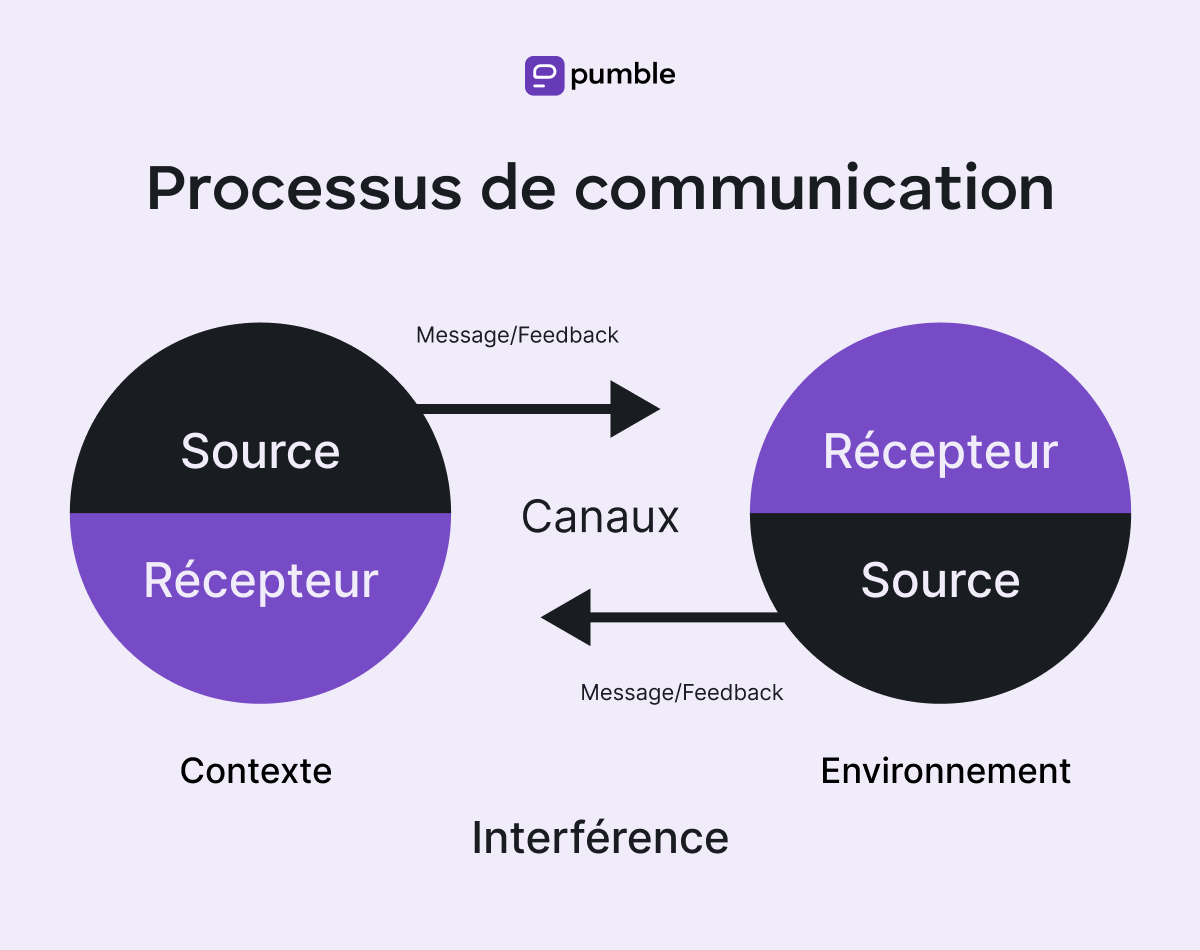
Comment la communication de l'équipe influence le travail d'équipe
La communication d’équipe est un élément crucial pour établir un bon travail d'équipe sur le lieu de travail.
Le flux de nouvelles idées, la reconnaissance de vos efforts, le retour d'information qui vous incite à vous améliorer encore, ou, en résumé, tout ce qui est bénéfique au travail d'équipe, nécessite une communication constante et adéquate.
Nous en avons parlé au Dr Raffaello Antonino, maître de conférences en psychologie de l'orientation, qui reconnaît que la communication au sein de l'équipe influence tous les aspects du travail d'équipe.

« La communication au sein de l'équipe est le ciment de toute l'opération. Elle a un impact direct sur le fonctionnement de l'équipe. Une communication efficace garantit que la charge de travail est répartie équitablement, ce qui favorise un sentiment d'unité et d'objectif commun. Elle élimine la confusion en définissant clairement le rôle et les responsabilités de chacun, ce qui accroît la productivité et la concentration. C'est aussi votre outil le plus puissant pour :
- Résoudre des conflits,
- Désamorcer les tensions, et
- Favoriser la compréhension. »
Dr Antonino ajoute que la communication influence également la dynamique de l'équipe à tous les niveaux :

« Et n'oublions pas que c'est par le biais de discussions décontractées et de rires partagés que des liens solides se créent, faisant du lieu de travail un endroit agréable. Par essence, la communication au sein de l'équipe est l'orchestrateur des coulisses du travail d'équipe, influençant subtilement mais significativement la dynamique de l'équipe. »
Jake Ciccarelli, expert en communication et en relations publiques, partage cet avis et ajoute qu'il existe trois points clés entre la communication et le travail d'équipe.

« La communication est liée au travail d'équipe de 3 manières principales :
Partager l'information — Le partage d'informations permet à l'équipe de voir si tout le monde est sur la même longueur d'onde à propos d'une tâche ou d'un projet en cours et fournit à tous les membres de l'équipe les informations appropriées et nécessaires.
Établir la confiance entre les personnes — La confiance naît du fait que l'on sait que l'on peut compter l'un sur l'autre en cas de difficultés.
Augmenter la productivité — La communication ouverte permet aux autres membres de l'équipe de se sentir à l'aise pour communiquer dans l'espace partagé. Lorsque quelqu'un se sent plus à l'aise, il communique tout problème potentiel, ce qui augmente les chances de réussite. »
Examinons d'autres aspects qui prouvent l'importance de la communication au sein d'une équipe.
Les avantages du travail d'équipe
C'est pourquoi une communication professionnelle efficace est de la plus haute importance, car le travail d'équipe en dépend.
Pourtant, le travail d'équipe présente une myriade d'avantages. Le travail d'équipe :
- Favorise les grandes idées — Selon John J. Murphy, auteur de “Pulling Together : 10 Rules for High-Performance Teamwork,” nous admirons peut-être les “génies solitaires”, mais tous les noms célèbres dont nous louons aujourd'hui les inventions et les compétences avaient derrière eux une équipe de personnes qui ont rendu tout cela possible dans une telle mesure.
- Encourage une prise de risque saine — Le travail en équipe permet aux individus de partager les responsabilités avec leurs collègues et les encourage donc à prendre des risques sains. Cela est bénéfique à la fois pour les employés (car cela les aide à être perçus sous un jour plus favorable) et pour les organisations (car cela permet aux travailleurs de proposer de nouvelles solutions à d'anciens problèmes).
- Rend les individus plus heureux (et plus performants) — Une étude d'Atlassian indique qu'un feedback honnête, le respect mutuel et l'ouverture personnelle (qui font tous partie intégrante d'un bon travail d'équipe) contribuent à ce que les membres d'une équipe soient 80% plus susceptibles de faire état d'un bien-être émotionnel élevé et 60% plus susceptibles d'obtenir davantage de résultats et d'effectuer leur travail plus rapidement.
- Aide les collègues à se développer en tant qu'individus — Le travail d'équipe peut aider les individus à comprendre leurs faiblesses et à s'efforcer de les améliorer. En outre, travailler en équipe signifie disposer d'un espace sûr pour évoluer out en étant soutenu par les autres membres de l'équipe (par la délégation, le feedback, etc.).
- Diminue le risque de burn-out — Selon une étude menée par Edelman Data and Intelligence, 50% des employés et 53% des cadres ont connu au moins un certain niveau d'épuisement professionnel. L'épuisement professionnel est lié au stress d'avoir beaucoup de travail à faire et pas assez de temps et de ressources pour le faire. Le travail d'équipe peut atténuer ce type de stress, car les équipes partagent la charge de travail.
Une étude de l'année 2021 sur le travail en équipe et la prise de décision en équipe a montré que les équipes ont tendance à parvenir à des conclusions par l'échange d'arguments et la communication, ce qui conduit à :
- Une meilleure performance,
- Une meilleure compréhension,
- Une collaboration plus facile,
- Une augmentation de la productivité,
- Une amélioration de la créativité,
- Une résolution plus facile des problèmes et
- Une diminution des risques de conflit.
En revanche, une mauvaise communication aura des effets négatifs considérables sur la plupart des équipes.
Conséquences d'une mauvaise communication au sein de l'équipe
Une mauvaise communication se produit lorsque l'émetteur et le récepteur ont une interprétation différente du message. Cela peut se produire pour de nombreuses raisons, mais les effets sont toujours les mêmes — une mauvaise communication.
Dans les équipes, ce problème peut se poser au niveau de l'interaction 1 à 1 entre les collègues, entre la direction et les employés, ainsi qu'au sein de l'équipe dans son ensemble.
Les effets d'une mauvaise communication prolongée au sein d'une équipe peuvent être graves :
- Environnement de travail instable,
- Baisse de la productivité,
- Perturbation de la collaboration,
- Baisse du moral,
- Tensions sur le lieu de travail,
- Conflit,
- Mauvaises relations avec l'extérieur et
- Perte de réputation.
Découvrons plus en détail chacune des conséquences d'une mauvaise communication.
Conséquence n°1 : Un environnement de travail instable
Lorsque les équipes ne parviennent pas à communiquer efficacement, elles sont facilement gagnées par l'incertitude et le stress constants liés à l'absence d'objectifs clairs.
Et, comme nous l'avons déjà mentionné, les employés qui ne savent pas ce que l'on attend d'eux sont moins susceptibles d'être motivés pour accomplir leurs tâches.
Conséquence n°2 : Une baisse de la productivité
Lorsque la communication est rompue, les membres de l'équipe ne peuvent pas fonctionner de manière optimale. Cela diminue l'engagement des employés.
Étant donné que 88 % des employés engagés aiment leur travail et que 50 % d'entre eux s'épanouissent dans leur vie personnelle et professionnelle, il est évident qu'une mauvaise communication peut avoir une incidence directe sur leur productivité.
Conséquence n°3 : Une perturbation de la collaboration au sein de l'équipe
Sans une communication efficace, les membres de l'équipe sont souvent livrés à eux-mêmes et incapables de collaborer correctement. Cela ferme la porte à l'innovation, au brainstorming et à toute autre forme de travail collaboratif.
Conséquence n°4 : Une baisse du moral des employés
En l'absence d'une communication adéquate, les employés peuvent se sentir sous-estimés, ce qui peut les amener à prendre du retard dans leur travail. Lorsque les employés sont découragés, ils sont moins motivés pour mettre leurs compétences au service de l'entreprise.
🎓 Astuce Pro de Pumble
Si vous cherchez un moyen d'augmenter le niveau de satisfaction et la productivité sur votre lieu de travail, consultez notre guide :
Conséquence n°5 : Des tensions et des conflits au travail
Dans une atmosphère d'incertitude et de mauvaise communication, la tension peut s'accumuler et perturber le flux de travail. L'effet le plus visible, et en même temps le plus préjudiciable, d'une mauvaise communication est le conflit entre collègues, qui peut nuire à l'ensemble de l'équipe.
🎓 Astuce Pro de Pumble
Si vous avez besoin d'aide pour gérer les tensions et les disputes sur le lieu de travail, consultez nos conseils d'experts :
Conséquence n°6 : Une mauvaise réputation et de mauvaises relations extérieures
Une mauvaise communication est contagieuse, et lorsque les membres de l'équipe communiquent mal, ils peuvent transmettre des messages confus, voire contradictoires, aux clients et à d'autres parties externes.
Lorsque la mauvaise communication devient la norme, c'est toute l'entreprise qui subit les conséquences, et lorsque les mauvaises critiques s'accumulent, c'est la réputation de l'organisation qui en prend un coup.
Conseils pour améliorer la communication de l'équipe
Selon les statistiques de Pumble sur la communication au travail en 2025, 40 % des chefs d'entreprise affirment qu'une mauvaise communication diminue la productivité et 32 % d'entre eux signalent un impact financier notable d'une mauvaise communication.
C'est pourquoi l'acquisition de solides compétences en communication d'équipe peut faire des merveilles pour vous et vos collègues. Mais quelle approche exacte pouvez-vous adopter pour parvenir à une communication efficace des groupes ?
Voici quelques conseils.
Conseil n°1 : Soyez honnête
L'honnêteté et la communication ouverte sont les bases d'un travail d'équipe réussi.
Cependant, les gens choisissent souvent de se conformer au travail par peur d'aller à contre-courant. En réalité, l'inauthenticité au travail crée une dissonance au sein d'une personne qui l'éloigne du reste de l'équipe.
De plus, lorsqu'un membre de l'équipe exprime son désaccord avec l'idée générale, il apporte une perspective différente qui peut profiter à tous.
Par exemple, supposons qu'un membre de l'équipe marketing soit le seul à remarquer que le nouveau slogan pourrait être mal interprété. S'il décide de se taire uniquement parce que tous les autres s'accordent à dire que le slogan est excellent, cela pourrait nuire gravement à la marque.
Toutefois, une communication honnête ne signifie pas qu'il faille dire tout ce que l'on pense de manière brutale et impolie.
Maintenir une communication positive tout en étant honnête est de la plus haute importance, car cela permet de construire des relations entre les équipes et d'accroître la motivation et la productivité (entre autres choses).
Jetez un œil à la conversation Pumble ci-dessous. Emilia exprime clairement son opinion, mais malgré cela, elle aurait pu formuler son message plus légèrement, surtout qu'elle tente de convaincre un groupe de personnes qui partagent son avis.
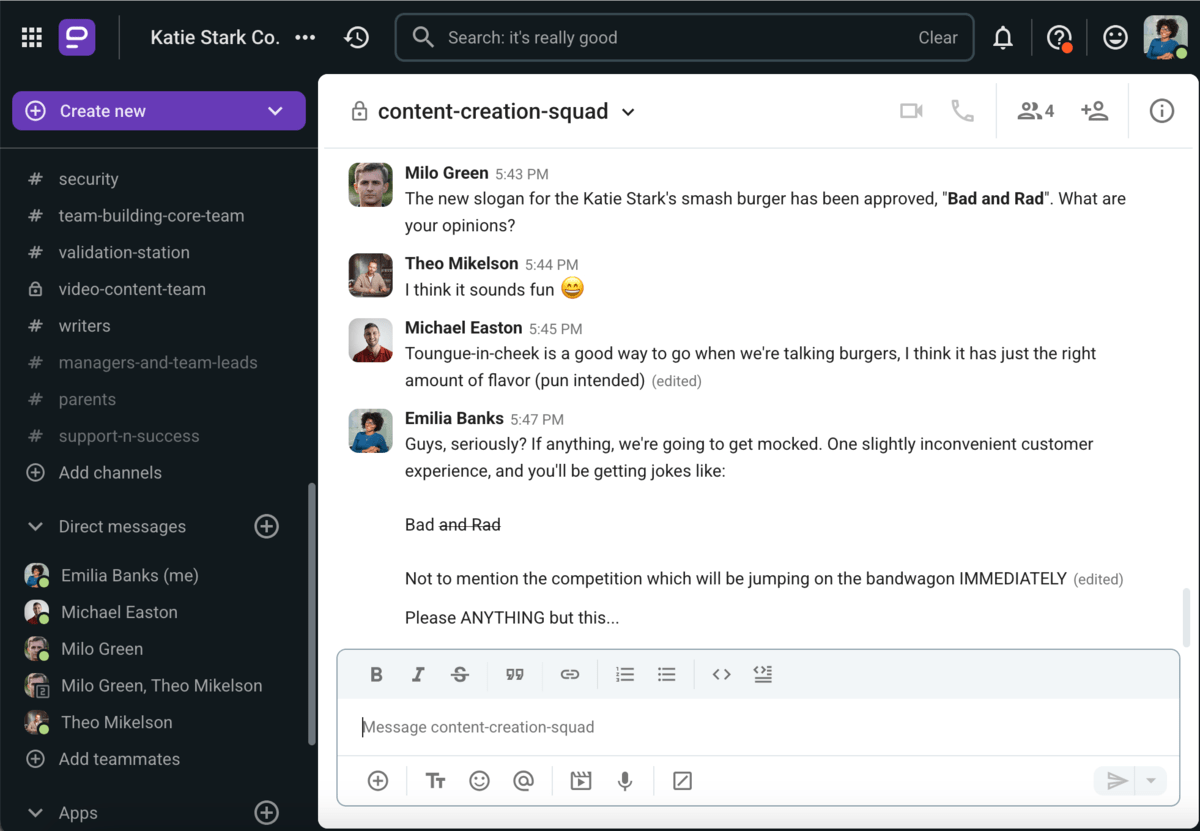
Créer une dynamique d'équipe positive avec Pumble
🎓 Astuce Pro de Pumble
Être malhonnête et se censurer dans l'espoir de maintenir un « statut social » est l'une des erreurs de communication les plus courantes commises par les employés. Découvrez quelles sont les 13 autres (et comment les surmonter) dans l'article suivant du blog de Pumble :
Conseil n°2 : Soyez clair et concis
L'une des composantes les plus importantes d'une communication d'équipe réussie est la capacité à transmettre le message de manière claire et précise.
Réfléchissez donc avant de parler tet essayez de faire passer votre message le plus efficacement possible.
Ne pas communiquer clairement amène les gens à se baser sur des hypothèses pour interpréter le message, ce qui est l'une des principales causes de rupture de la communication.
La mauvaise communication, en général, conduit à des malentendus, et ces derniers peuvent causer toutes sortes de problèmes au sein de votre équipe, tels que :
- Des délais non respectés,
- Des erreurs,
- Des goulets d'étranglement dans le flux de travail, et même
- Des conflits.
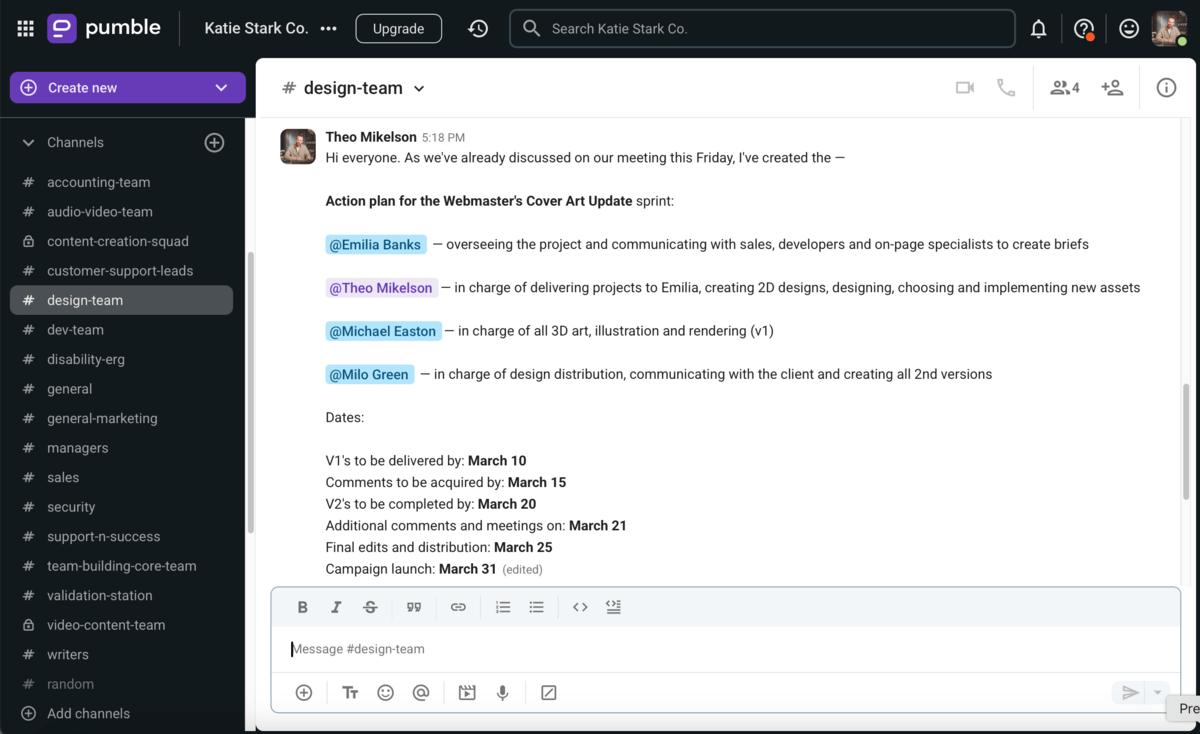
Encourager une communication d'équipe efficace avec Pumble
Conseil n°3 : Soyez respectueux et attentionné
Des recherches sur la communication respectueuse au travail, présentées dans une étude récente, ont montré que les gens accordent plus d’importance à l’engagement respectueux qu’à l’autonomie, à la sécurité de l’emploi et aux revenus élevés.
Veillez donc à respecter le temps et l'énergie de vos collègues et à ne pas les surcharger. Si vous souhaitez déléguer une tâche à quelqu'un, vérifiez d'abord s'il a le temps et s'il est prêt à l'accomplir. Si une personne est en pause et ne fait rien, cela ne signifie pas qu'elle est disponible pour travailler.
Être prévenant peut également signifier offrir de l'aide si vous voyez que quelqu'un a des difficultés ou même apporter une tasse de thé à un collègue stressé.
Des choses apparemment insignifiantes peuvent faire beaucoup et renforcer réellement les relations au sein de l'équipe.
Conseil n°4 : Utilisez la communication non violente (CNV)
La communication non violente est un concept créé par Marshall Rosenberg, Ph.D., présenté dans son livre Nonviolent Communication : A Language of Life. Ce processus comprend :
- Observer sans juger,
- Exprimer ses sentiments,
- Exprimer ses besoins et
- Exprimer ses demandes.
Nous avons demandé à Avigail Lev, psychothérapeute, auteur, médiateur et coach exécutif, quels sont, selon elle, les avantages de la CNV. Elle affirme qu'elle ouvre de nombreuses possibilités pour la communication au sein d'une équipe.

« La communication non violente est un outil puissant qui favorise les scénarios gagnant-gagnant dans la résolution des problèmes. Elle apprend aux gens à se concentrer sur l'identification des besoins sous-jacents plutôt que sur les désirs superficiels, ce qui nous permet de comprendre réellement ce qui est important pour chaque partie concernée.
Lorsque nous pouvons faire la distinction entre les désirs et les besoins, nous pouvons nous engager dans des négociations qui sont plus susceptibles de répondre aux besoins fondamentaux de chacun, en cultivant un sentiment de satisfaction et de coopération.
Cette approche ouvre la voie à des solutions créatives qui nous permettent de passer de positions rigides à l'exploration flexible d'options qui répondent aux besoins sous-jacents de toutes les parties. »
Elle ajoute qu'en utilisant la CNV, nous pouvons parvenir à des solutions gagnant-gagnant souvent inaccessibles.

« Lorsque nous reconnaissons, valorisons et négocions des besoins divers, nous pouvons trouver des scénarios gagnant-gagnant qui favorisent la compréhension, la collaboration et les résolutions durables.
La CNV nous aide à comprendre nos propres limites, nos besoins et nos désirs, ce qui nous permet de communiquer plus efficacement et de trouver des solutions gagnant-gagnant qui profitent à tout le monde. Elle nous aide également à développer une meilleure compréhension de nous-mêmes, en favorisant la conscience de soi et en nous permettant de nous connecter à nos propres émotions et besoins.
Cette conscience de soi nous permet de communiquer nos pensées et nos émotions avec plus d'authenticité et d'assurance. »
Conseil n°5 : Écoutez attentivement
Faire passer votre message avec succès n'est qu'une partie du travail. Une bonne communication d'équipe repose également sur l'écoute active. Il s'agit d'une compétence que vous pouvez mettre en pratique en étant attentif à ce que disent vos collègues et en comprenant réellement leurs points de vue.
Pour vous assurer que vous faites de votre mieux pour écouter activement lorsque vous recevez un message, vous pouvez essayer de :
- Ajuster votre attitude — Une attitude positive vous rend plus réceptif à ce que les autres ont à dire.
- Prêter attention — Le fait de prêter attention et de se concentrer sur les signaux verbaux et non verbaux que les gens nous envoient nous permet de mieux écouter.
- Ajuster votre réponse — Ne pas faire de suppositions et être flexible lorsque vous écoutez ce que l'expéditeur du message essaie de transmettre est également une caractéristique importante de l'écoute active.
De cette manière, vous améliorerez non seulement la communication et la collaboration au sein de votre équipe, mais vous ferez également preuve de respect envers les autres membres de l'équipe et leurs opinions.
🎓 Astuce Pro de Pumble
L'écoute active est l'une des compétences essentielles des communicateurs efficaces. Pour en savoir plus, consultez cet article de Pumble Learn :
Conseil n°6 : Choisissez le meilleur canal pour transmettre votre message
Une communication efficace et efficiente dépend également de l'utilisation intelligente des différents canaux de communication par l'équipe.
Choisir le bon canal pour contacter un collègue est particulièrement important si vous travaillez dans une équipe à distance et que vous ne pouvez pas simplement vous rendre à son bureau pour lui poser une question.
Mais même au bureau, la communication en face à face n'est souvent pas la meilleure option. Par exemple, vous n'irez pas déléguer des tâches d'une personne à l'autre si vous pouvez le faire par l'intermédiaire d'une plateforme de gestion de projet. De même, vous ne vous lèverez pas au milieu du bureau pour crier une annonce que vous devez faire à tout un groupe de personnes.
Au lieu de cela, vous utiliserez plutôt un autre canal, mieux adapté à la communication organisationnelle.
De même, même dans le cadre de conversations individuelles, lorsque les travailleurs à distance ont besoin de consulter leurs collègues sur un problème, il est beaucoup plus pratique d'en discuter dans une application de communication d'équipe, telle que Pumble, plutôt que d'envoyer des emails dans tous les sens.
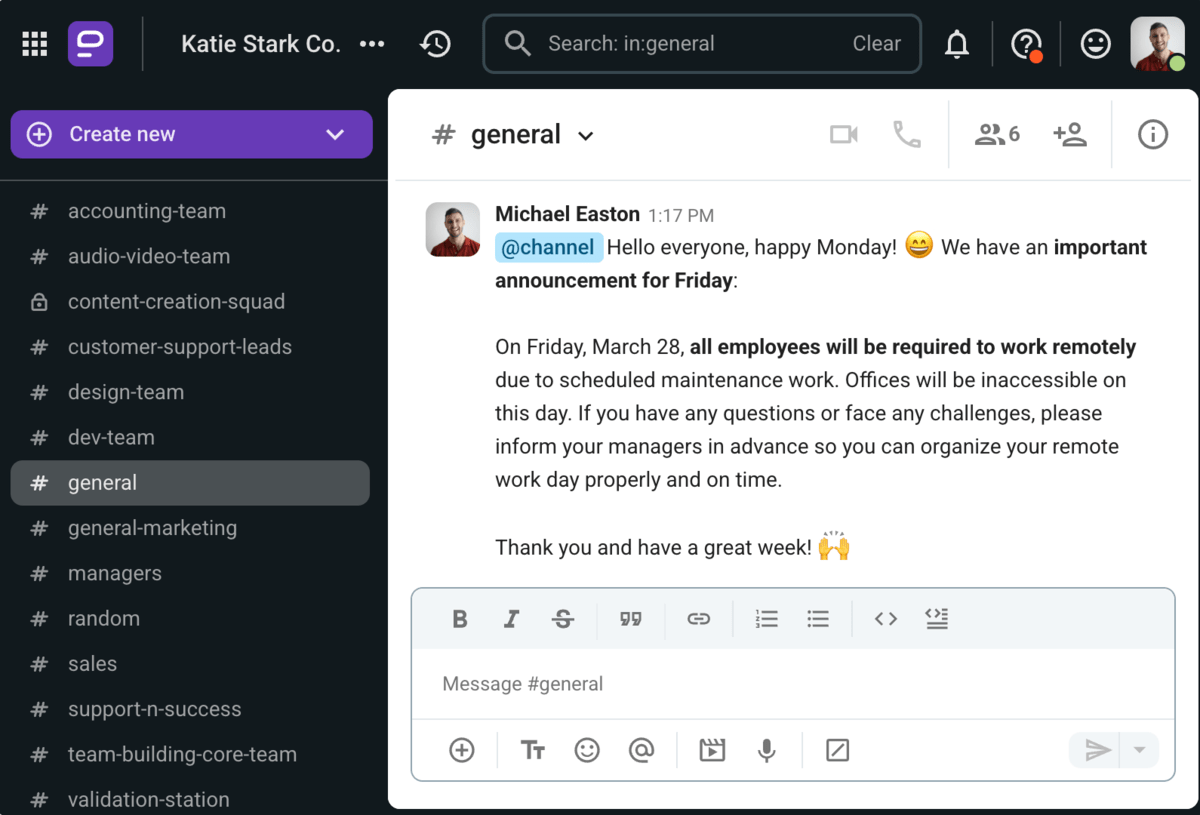
🎓 Astuce Pro de Pumble
Maintenir la communication via les canaux appropriés est l'un des meilleurs moyens de permettre à votre équipe distante de se sentir connectée. Voici quelques autres conseils sur la façon de procéder :
Conseil n°7 : Trouvez les styles de communication préférés de chacun
En plus de trouver le canal de communication qui répond le mieux aux besoins de chacun, il est également essentiel que vous compreniez le style de communication préféré de chaque membre de l’équipe.
Tout le monde ne communiquera pas de la même manière (tout comme ils ne recevront pas le même message de la même manière).
Nous avons interrogé Ciccarelli à ce sujet et il a déclaré que reconnaître les différences dans la communication peut être la meilleure stratégie pour améliorer l'efficacité de la communication.

« Initiez une discussion approfondie sur le style de communication préféré de chaque membre de l’équipe.
Reconnaître que les individus peuvent avoir des préférences et des défis uniques en matière de communication permet à l'équipe d'adapter ses approches en conséquence. En particulier, certains membres de l’équipe peuvent avoir du mal à demander de l'aide, C’est pourquoi offrir de l’aide de manière proactive sans attendre une demande directe peut être un moyen efficace de prendre contact avec eux.
Cette approche proactive démontre un soutien et favorise un environnement dans lequel les membres de l’équipe se sentent à l’aise pour demander de l’aide en cas de besoin. »
Conseil n°8 : Soyez ouvert au feedback et à la critique constructive
Personne n’est à l’abri des erreurs et nous ne pouvons souvent pas voir nos propres erreurs. C'est pourquoi nous devons valoriser les critiques constructives de nos collègues, car elles peuvent nous aider à apprendre, à grandir et à rester engagés.
Les critiques constructives sont tout aussi importantes que la reconnaissance des employés pour leur amélioration et leur engagement, nous devrions donc accueillir les deux. En fait, les commentaires, quels qu’ils soient, encouragent l’engagement : ¼ des employées féminines et ⅕ des employés masculins déclarent que fournir des commentaires et de la reconnaissance est un puissant outil d’engagement.
Même si vous n’êtes pas d’accord avec les commentaires que vous recevez, prenez-les avec grâce et ne vous offensez pas. Expliquez simplement votre point de vue et essayez de trouver un terrain d’entente. Là où il y a place au feedback, il y a place à l’amélioration.
Être ouvert aux critiques constructives signifie permettre aux membres de votre équipe de vous inciter à toujours vous efforcer de vous améliorer dans ce que vous faites.
Conseil n°9 : Abordez les problèmes au fur et à mesure qu'ils se présentent
Lorsqu’ils ne sont pas résolus, même les petits problèmes ont tendance à créer des frustrations qui finissent par entraîner des problèmes majeurs au sein de l’équipe. Donc, si quelque chose vous dérange, assurez-vous de le communiquer sur un ton respectueux et neutre et essayez d'y remédier immédiatement.
La communication au sein d’équipes de travail performantes est libre et n’empêche pas de faire face à des choses difficiles.
Vous aurez peut-être du mal à résoudre le problème, mais en le résolvant immédiatement, vous clarifierez les choses et vous éviterez de développer du ressentiment.
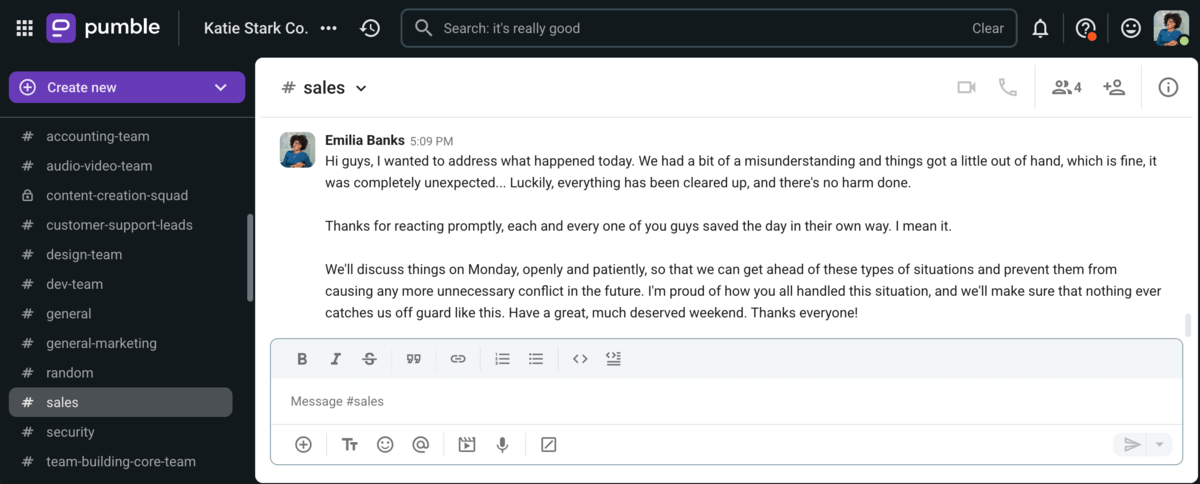
Ne laissez aucun problème sans solution avec Pumble
Conseil n° 10 : Adoptez une communication ascendante
Enfin, assurez-vous que tous les membres de l'équipe, quelle que soit leur place dans la hiérarchie de l'équipe, sont inclus dans la conversation. C'est quelque chose que le Dr Antonino souligne comme étant particulièrement important pour le travail d'équipe et le succès global de l'équipe.

« Souvent, les meilleures idées viennent de ceux qui sont en première ligne, mais elles peuvent être étouffées par la dynamique hiérarchique. Encourager la communication de ceux qui se trouvent aux échelons inférieurs de l’échelle jusqu’au sommet peut changer la donne. C’est comme ouvrir les fenêtres et laisser entrer de l’air frais dans votre planification stratégique, donnant à chacun un sentiment d’appropriation et de responsabilité. »
Le Dr Antonino vous invite également à vous rappeler qu’une communication d’équipe efficace n’est pas à sens unique.

« N'oubliez pas qu'il ne s'agit pas seulement d'extraire des idées de votre équipe. Il s’agit également de favoriser une atmosphère de confiance et de respect, dans laquelle chacun sent que sa voix compte. Et il va sans dire que les dirigeants doivent être préparés à la fois aux commentaires constructifs et aux dures vérités occasionnelles. Comme on dit, la vérité peut faire mal, mais elle peut aussi guérir et ouvrir la voie à la croissance. »
🎓 Astuce Pro de Pumble
Il est clair que la communication est de la plus haute importance. Si vous souhaitez l'améliorer encore, consultez ces 2 articles Pumble :
Amplifier la communication interne de l'équipe avec Pumble
L'un des moyens les plus simples d'améliorer la communication dans votre équipe est de la rendre simple, accessible et efficace. Aujourd'hui, la meilleure façon d'y parvenir est d'utiliser des applications de communication interne dédiées comme Pumble.
Pumble offre aux utilisateurs une polyvalence substantielle pour différents types de communication, notamment :
- Communication écrite par messages directs et partage de documents importants, et
- Communication verbale par appels vocaux, messages vocaux et vidéo et réunions virtuelles.
Pumble fonctionne comme votre QG numérique, ce qui vous permet d'être flexible dans la manière dont vous informez vos collègues, abordez les problèmes et formulez des idées.
De plus, Pumble vous encourage à communiquer de manière concise et efficace, à mémoriser les processus importants grâce à des rappels personnalisés et à suivre l'information via des fils de discussion.
Améliorez les efforts de communication de votre équipe dès aujourd'hui et commencez à utiliser les meilleures pratiques de communication de manière intuitive. Essayez Pumble de CAKE.com dès aujourd'hui !
Comment nous examinons cet article : Nos rédacteurs et éditeurs vérifient les articles et les mettent à jour lorsque de nouvelles informations sont disponibles, afin qu'ils soient toujours d'actualité.

